Behavioural Change Report
VerifiedAdded on 2023/01/13
|13
|3343
|58
AI Summary
This report discusses the rationale for focusing on behaviour change intervention with a specific population. It also provides a critical review of theoretical perspectives applied to supporting behaviour change. The report further explores potential barriers at different levels and strategies to overcome them.
Contribute Materials
Your contribution can guide someone’s learning journey. Share your
documents today.
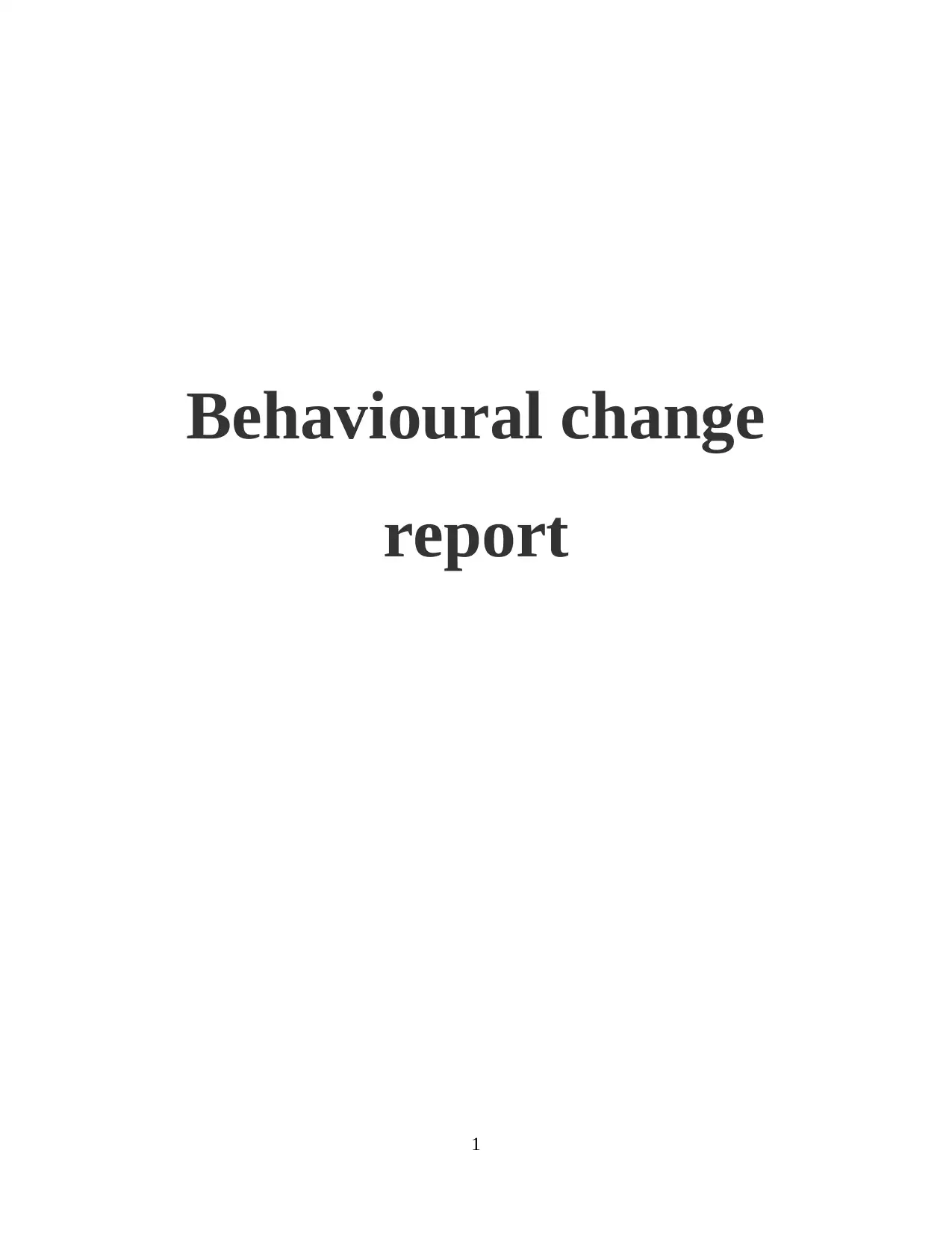
Behavioural change
report
1
report
1
Secure Best Marks with AI Grader
Need help grading? Try our AI Grader for instant feedback on your assignments.
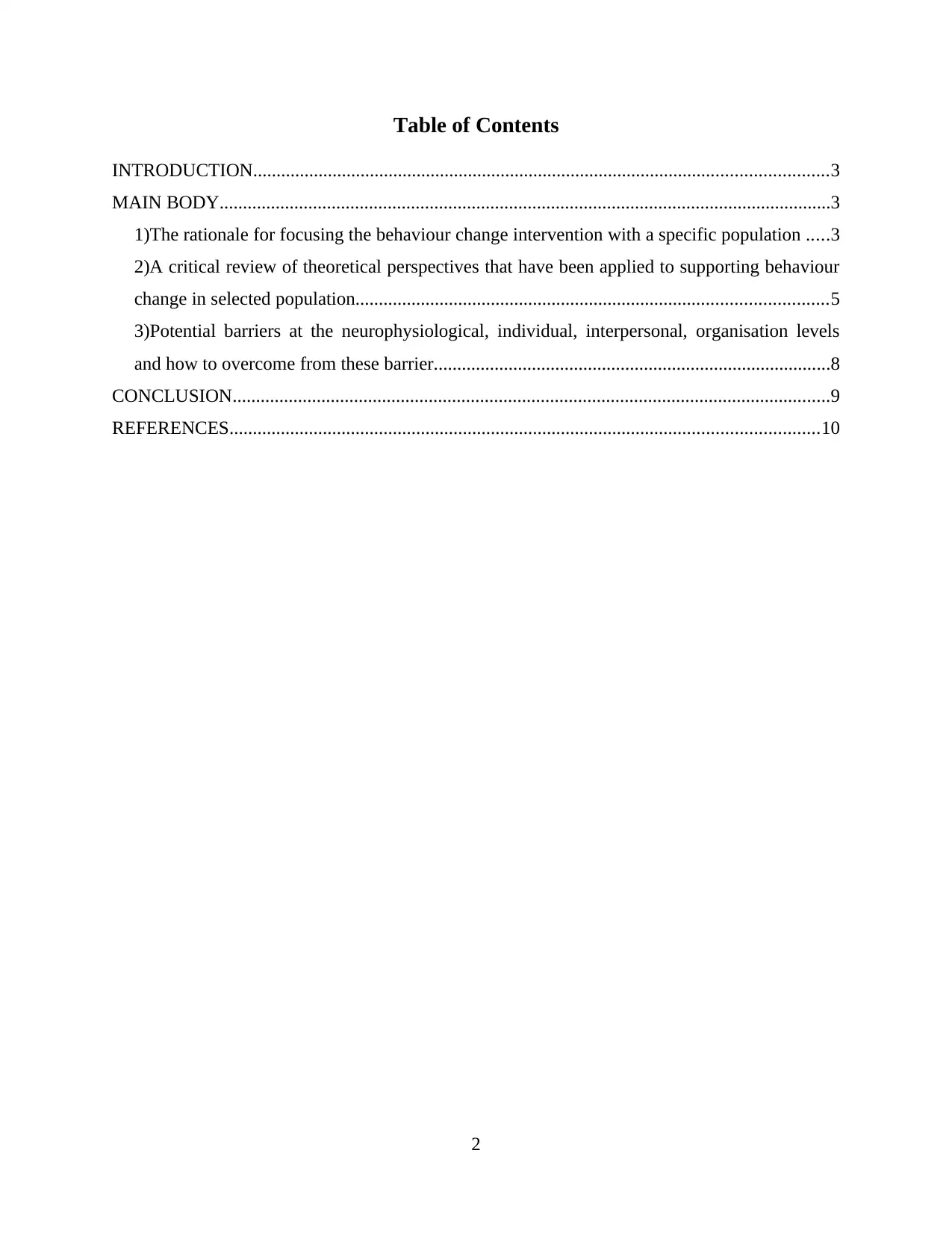
Table of Contents
INTRODUCTION...........................................................................................................................3
MAIN BODY...................................................................................................................................3
1)The rationale for focusing the behaviour change intervention with a specific population .....3
2)A critical review of theoretical perspectives that have been applied to supporting behaviour
change in selected population.....................................................................................................5
3)Potential barriers at the neurophysiological, individual, interpersonal, organisation levels
and how to overcome from these barrier.....................................................................................8
CONCLUSION................................................................................................................................9
REFERENCES..............................................................................................................................10
2
INTRODUCTION...........................................................................................................................3
MAIN BODY...................................................................................................................................3
1)The rationale for focusing the behaviour change intervention with a specific population .....3
2)A critical review of theoretical perspectives that have been applied to supporting behaviour
change in selected population.....................................................................................................5
3)Potential barriers at the neurophysiological, individual, interpersonal, organisation levels
and how to overcome from these barrier.....................................................................................8
CONCLUSION................................................................................................................................9
REFERENCES..............................................................................................................................10
2
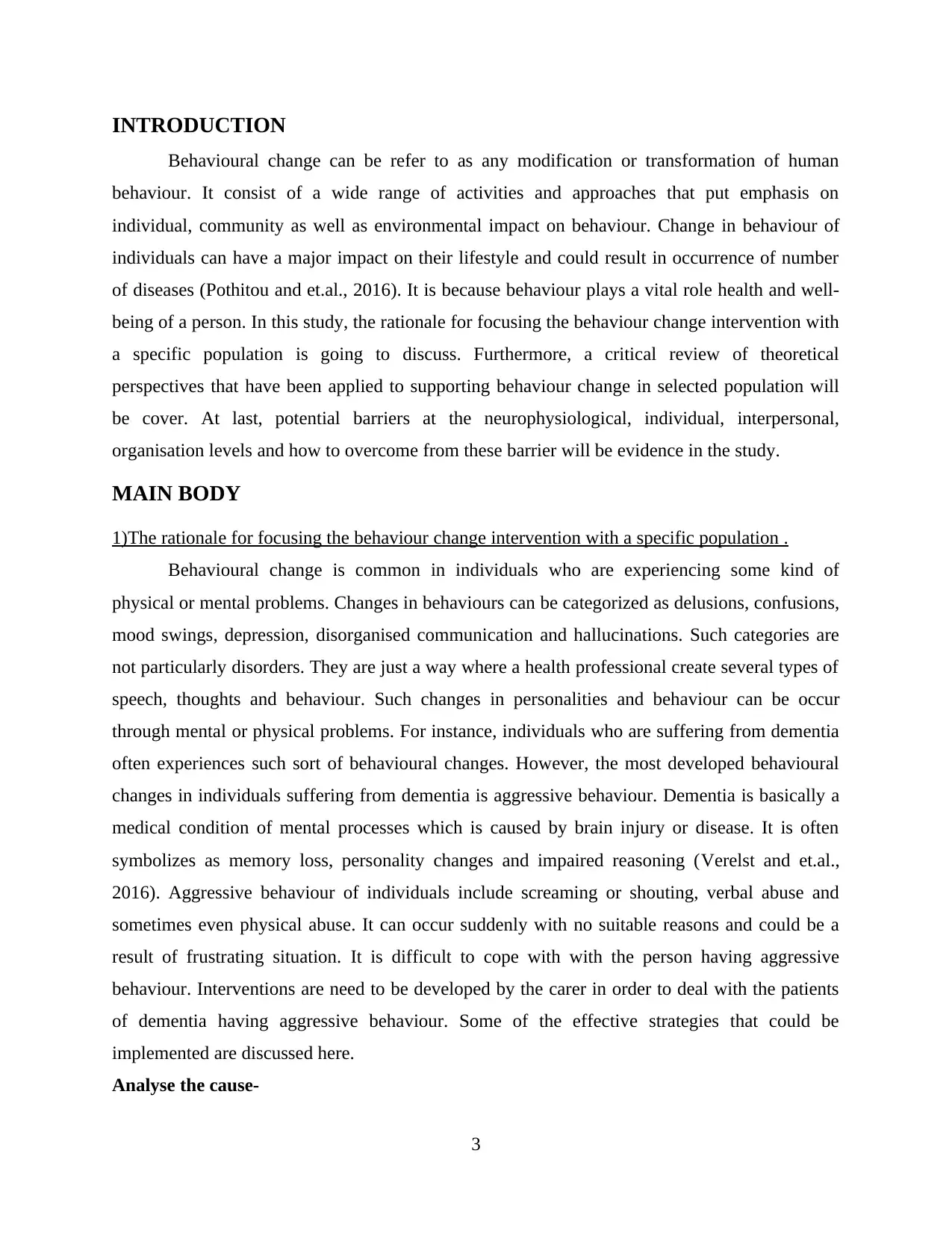
INTRODUCTION
Behavioural change can be refer to as any modification or transformation of human
behaviour. It consist of a wide range of activities and approaches that put emphasis on
individual, community as well as environmental impact on behaviour. Change in behaviour of
individuals can have a major impact on their lifestyle and could result in occurrence of number
of diseases (Pothitou and et.al., 2016). It is because behaviour plays a vital role health and well-
being of a person. In this study, the rationale for focusing the behaviour change intervention with
a specific population is going to discuss. Furthermore, a critical review of theoretical
perspectives that have been applied to supporting behaviour change in selected population will
be cover. At last, potential barriers at the neurophysiological, individual, interpersonal,
organisation levels and how to overcome from these barrier will be evidence in the study.
MAIN BODY
1)The rationale for focusing the behaviour change intervention with a specific population .
Behavioural change is common in individuals who are experiencing some kind of
physical or mental problems. Changes in behaviours can be categorized as delusions, confusions,
mood swings, depression, disorganised communication and hallucinations. Such categories are
not particularly disorders. They are just a way where a health professional create several types of
speech, thoughts and behaviour. Such changes in personalities and behaviour can be occur
through mental or physical problems. For instance, individuals who are suffering from dementia
often experiences such sort of behavioural changes. However, the most developed behavioural
changes in individuals suffering from dementia is aggressive behaviour. Dementia is basically a
medical condition of mental processes which is caused by brain injury or disease. It is often
symbolizes as memory loss, personality changes and impaired reasoning (Verelst and et.al.,
2016). Aggressive behaviour of individuals include screaming or shouting, verbal abuse and
sometimes even physical abuse. It can occur suddenly with no suitable reasons and could be a
result of frustrating situation. It is difficult to cope with with the person having aggressive
behaviour. Interventions are need to be developed by the carer in order to deal with the patients
of dementia having aggressive behaviour. Some of the effective strategies that could be
implemented are discussed here.
Analyse the cause-
3
Behavioural change can be refer to as any modification or transformation of human
behaviour. It consist of a wide range of activities and approaches that put emphasis on
individual, community as well as environmental impact on behaviour. Change in behaviour of
individuals can have a major impact on their lifestyle and could result in occurrence of number
of diseases (Pothitou and et.al., 2016). It is because behaviour plays a vital role health and well-
being of a person. In this study, the rationale for focusing the behaviour change intervention with
a specific population is going to discuss. Furthermore, a critical review of theoretical
perspectives that have been applied to supporting behaviour change in selected population will
be cover. At last, potential barriers at the neurophysiological, individual, interpersonal,
organisation levels and how to overcome from these barrier will be evidence in the study.
MAIN BODY
1)The rationale for focusing the behaviour change intervention with a specific population .
Behavioural change is common in individuals who are experiencing some kind of
physical or mental problems. Changes in behaviours can be categorized as delusions, confusions,
mood swings, depression, disorganised communication and hallucinations. Such categories are
not particularly disorders. They are just a way where a health professional create several types of
speech, thoughts and behaviour. Such changes in personalities and behaviour can be occur
through mental or physical problems. For instance, individuals who are suffering from dementia
often experiences such sort of behavioural changes. However, the most developed behavioural
changes in individuals suffering from dementia is aggressive behaviour. Dementia is basically a
medical condition of mental processes which is caused by brain injury or disease. It is often
symbolizes as memory loss, personality changes and impaired reasoning (Verelst and et.al.,
2016). Aggressive behaviour of individuals include screaming or shouting, verbal abuse and
sometimes even physical abuse. It can occur suddenly with no suitable reasons and could be a
result of frustrating situation. It is difficult to cope with with the person having aggressive
behaviour. Interventions are need to be developed by the carer in order to deal with the patients
of dementia having aggressive behaviour. Some of the effective strategies that could be
implemented are discussed here.
Analyse the cause-
3
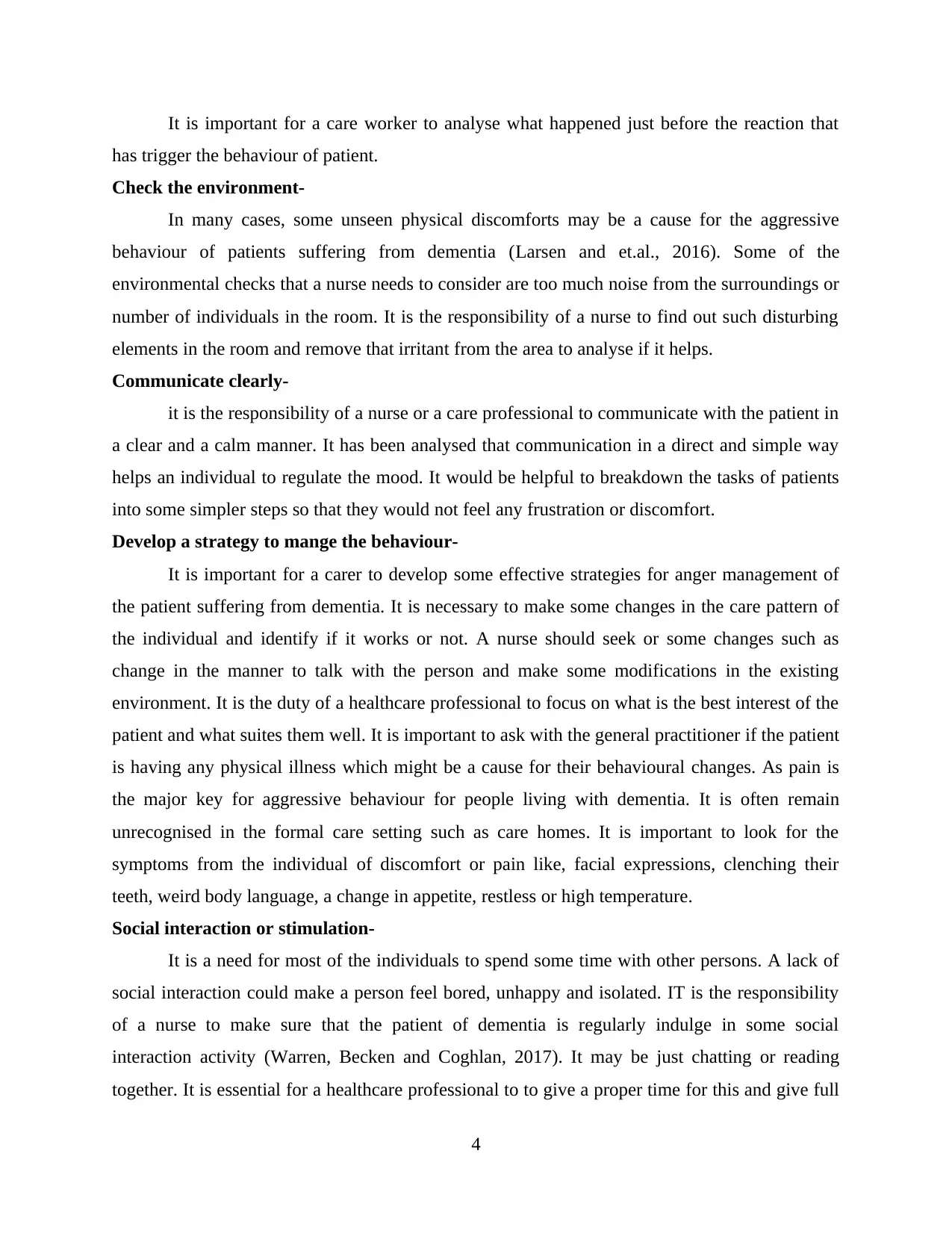
It is important for a care worker to analyse what happened just before the reaction that
has trigger the behaviour of patient.
Check the environment-
In many cases, some unseen physical discomforts may be a cause for the aggressive
behaviour of patients suffering from dementia (Larsen and et.al., 2016). Some of the
environmental checks that a nurse needs to consider are too much noise from the surroundings or
number of individuals in the room. It is the responsibility of a nurse to find out such disturbing
elements in the room and remove that irritant from the area to analyse if it helps.
Communicate clearly-
it is the responsibility of a nurse or a care professional to communicate with the patient in
a clear and a calm manner. It has been analysed that communication in a direct and simple way
helps an individual to regulate the mood. It would be helpful to breakdown the tasks of patients
into some simpler steps so that they would not feel any frustration or discomfort.
Develop a strategy to mange the behaviour-
It is important for a carer to develop some effective strategies for anger management of
the patient suffering from dementia. It is necessary to make some changes in the care pattern of
the individual and identify if it works or not. A nurse should seek or some changes such as
change in the manner to talk with the person and make some modifications in the existing
environment. It is the duty of a healthcare professional to focus on what is the best interest of the
patient and what suites them well. It is important to ask with the general practitioner if the patient
is having any physical illness which might be a cause for their behavioural changes. As pain is
the major key for aggressive behaviour for people living with dementia. It is often remain
unrecognised in the formal care setting such as care homes. It is important to look for the
symptoms from the individual of discomfort or pain like, facial expressions, clenching their
teeth, weird body language, a change in appetite, restless or high temperature.
Social interaction or stimulation-
It is a need for most of the individuals to spend some time with other persons. A lack of
social interaction could make a person feel bored, unhappy and isolated. IT is the responsibility
of a nurse to make sure that the patient of dementia is regularly indulge in some social
interaction activity (Warren, Becken and Coghlan, 2017). It may be just chatting or reading
together. It is essential for a healthcare professional to to give a proper time for this and give full
4
has trigger the behaviour of patient.
Check the environment-
In many cases, some unseen physical discomforts may be a cause for the aggressive
behaviour of patients suffering from dementia (Larsen and et.al., 2016). Some of the
environmental checks that a nurse needs to consider are too much noise from the surroundings or
number of individuals in the room. It is the responsibility of a nurse to find out such disturbing
elements in the room and remove that irritant from the area to analyse if it helps.
Communicate clearly-
it is the responsibility of a nurse or a care professional to communicate with the patient in
a clear and a calm manner. It has been analysed that communication in a direct and simple way
helps an individual to regulate the mood. It would be helpful to breakdown the tasks of patients
into some simpler steps so that they would not feel any frustration or discomfort.
Develop a strategy to mange the behaviour-
It is important for a carer to develop some effective strategies for anger management of
the patient suffering from dementia. It is necessary to make some changes in the care pattern of
the individual and identify if it works or not. A nurse should seek or some changes such as
change in the manner to talk with the person and make some modifications in the existing
environment. It is the duty of a healthcare professional to focus on what is the best interest of the
patient and what suites them well. It is important to ask with the general practitioner if the patient
is having any physical illness which might be a cause for their behavioural changes. As pain is
the major key for aggressive behaviour for people living with dementia. It is often remain
unrecognised in the formal care setting such as care homes. It is important to look for the
symptoms from the individual of discomfort or pain like, facial expressions, clenching their
teeth, weird body language, a change in appetite, restless or high temperature.
Social interaction or stimulation-
It is a need for most of the individuals to spend some time with other persons. A lack of
social interaction could make a person feel bored, unhappy and isolated. IT is the responsibility
of a nurse to make sure that the patient of dementia is regularly indulge in some social
interaction activity (Warren, Becken and Coghlan, 2017). It may be just chatting or reading
together. It is essential for a healthcare professional to to give a proper time for this and give full
4
Secure Best Marks with AI Grader
Need help grading? Try our AI Grader for instant feedback on your assignments.

attention to patient. A care professional must develop or plan some new activities where both of
them could enjoy and perform some daily tasks where a patient can take part. This particular
intervention would be most helpful for a patient as he/she will get distracted form other
disturbing elements which is a result of their aggressive behaviour.
Reminiscence-
It is refereed to as life stories activities that involve talking about past experiences like
sharing pictures of patients family or some events form the past. It must be positive and relevant
such as a family event, places they have been through and their favourite football match. Such
kinds of activities are proved to be beneficial for the dementia patients and help to eliminate the
risks of aggressive behaviour (Gronau, 2017). Nurses could also develop a life story book of
them. It would help a dementia patient at the centre of the care and help to regulate their
behaviour.
2)A critical review of theoretical perspectives that have been applied to supporting behaviour
change in selected population.
Theories of behavioural change is to explain the reasons and causes behind changing in
behaviour of an individual. Such theories explains about personal, environmental as well as
behavioural characteristics as crucial factors in determining behaviour of individuals. It would be
helpful for a care professional to implement some behavioural theories on patients of dementia
who are found with aggressive behavioural patterns. Care professionals make most of the efforts
to improve health conditions of patients that majorly requires some changes in behaviour
weather through reducing destructive behaviour or through promotion of a healthier life style.
Some of the theories which could be helpful for anger management of individuals experiencing
dementia is discussed here.
Social cognitive theory-
The social cognitive theory is a learning theory proposed by Albert Bandura in the year
1960. It offers a framework regarding how individuals are shaped by their surrounding
environment. Specifically, the theory explains the processes of observational modelling and
learning along with the impact of self-efficacy on development of behaviour. It discuss about
individuals personal experiences and actions of other individuals (Olins, 2017). Theory also
focus on impact of environmental factors on health behaviours of individuals. Some of the key
components related with the theory are discussed as follows:
5
them could enjoy and perform some daily tasks where a patient can take part. This particular
intervention would be most helpful for a patient as he/she will get distracted form other
disturbing elements which is a result of their aggressive behaviour.
Reminiscence-
It is refereed to as life stories activities that involve talking about past experiences like
sharing pictures of patients family or some events form the past. It must be positive and relevant
such as a family event, places they have been through and their favourite football match. Such
kinds of activities are proved to be beneficial for the dementia patients and help to eliminate the
risks of aggressive behaviour (Gronau, 2017). Nurses could also develop a life story book of
them. It would help a dementia patient at the centre of the care and help to regulate their
behaviour.
2)A critical review of theoretical perspectives that have been applied to supporting behaviour
change in selected population.
Theories of behavioural change is to explain the reasons and causes behind changing in
behaviour of an individual. Such theories explains about personal, environmental as well as
behavioural characteristics as crucial factors in determining behaviour of individuals. It would be
helpful for a care professional to implement some behavioural theories on patients of dementia
who are found with aggressive behavioural patterns. Care professionals make most of the efforts
to improve health conditions of patients that majorly requires some changes in behaviour
weather through reducing destructive behaviour or through promotion of a healthier life style.
Some of the theories which could be helpful for anger management of individuals experiencing
dementia is discussed here.
Social cognitive theory-
The social cognitive theory is a learning theory proposed by Albert Bandura in the year
1960. It offers a framework regarding how individuals are shaped by their surrounding
environment. Specifically, the theory explains the processes of observational modelling and
learning along with the impact of self-efficacy on development of behaviour. It discuss about
individuals personal experiences and actions of other individuals (Olins, 2017). Theory also
focus on impact of environmental factors on health behaviours of individuals. Some of the key
components related with the theory are discussed as follows:
5
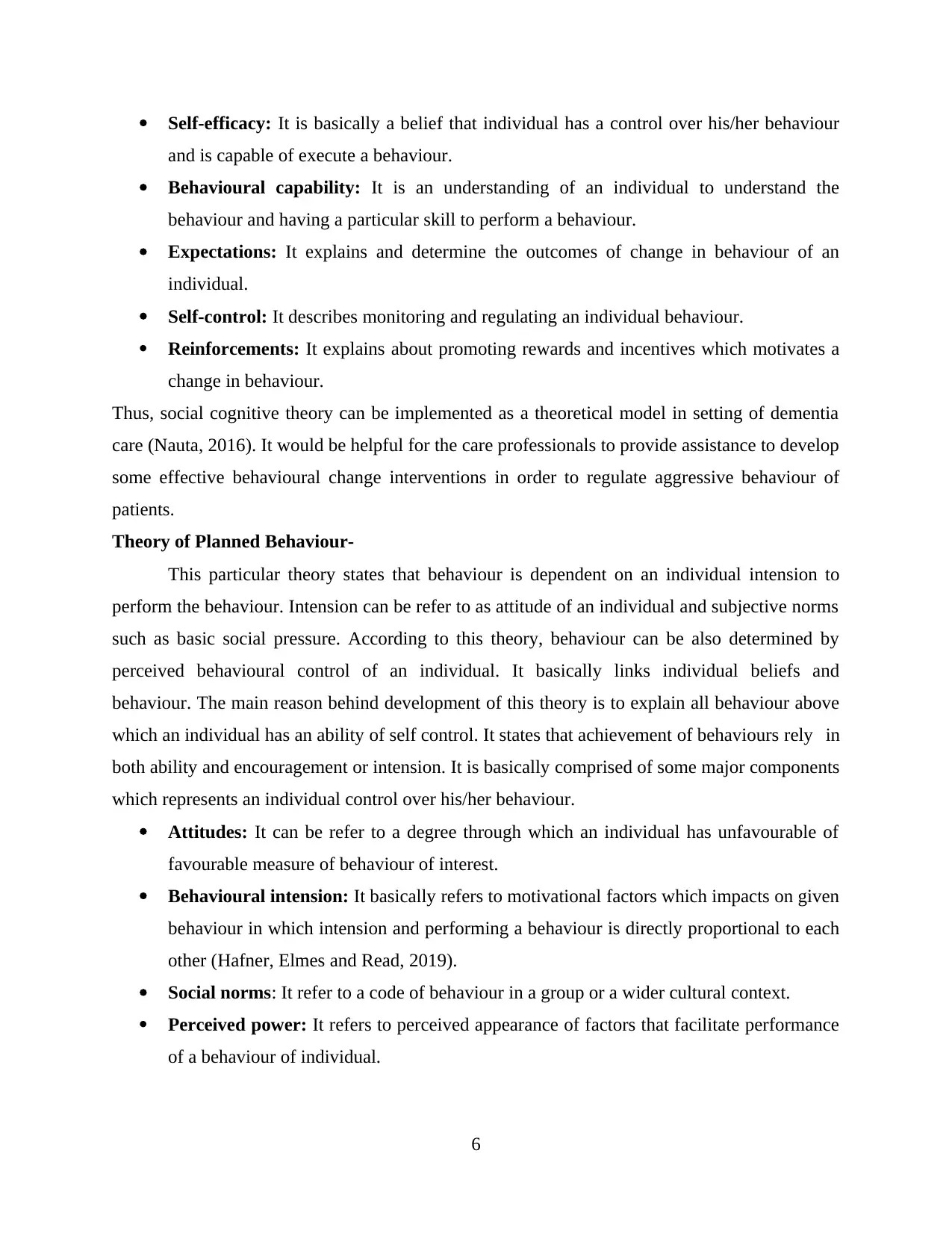
Self-efficacy: It is basically a belief that individual has a control over his/her behaviour
and is capable of execute a behaviour.
Behavioural capability: It is an understanding of an individual to understand the
behaviour and having a particular skill to perform a behaviour.
Expectations: It explains and determine the outcomes of change in behaviour of an
individual.
Self-control: It describes monitoring and regulating an individual behaviour.
Reinforcements: It explains about promoting rewards and incentives which motivates a
change in behaviour.
Thus, social cognitive theory can be implemented as a theoretical model in setting of dementia
care (Nauta, 2016). It would be helpful for the care professionals to provide assistance to develop
some effective behavioural change interventions in order to regulate aggressive behaviour of
patients.
Theory of Planned Behaviour-
This particular theory states that behaviour is dependent on an individual intension to
perform the behaviour. Intension can be refer to as attitude of an individual and subjective norms
such as basic social pressure. According to this theory, behaviour can be also determined by
perceived behavioural control of an individual. It basically links individual beliefs and
behaviour. The main reason behind development of this theory is to explain all behaviour above
which an individual has an ability of self control. It states that achievement of behaviours rely in
both ability and encouragement or intension. It is basically comprised of some major components
which represents an individual control over his/her behaviour.
Attitudes: It can be refer to a degree through which an individual has unfavourable of
favourable measure of behaviour of interest.
Behavioural intension: It basically refers to motivational factors which impacts on given
behaviour in which intension and performing a behaviour is directly proportional to each
other (Hafner, Elmes and Read, 2019).
Social norms: It refer to a code of behaviour in a group or a wider cultural context.
Perceived power: It refers to perceived appearance of factors that facilitate performance
of a behaviour of individual.
6
and is capable of execute a behaviour.
Behavioural capability: It is an understanding of an individual to understand the
behaviour and having a particular skill to perform a behaviour.
Expectations: It explains and determine the outcomes of change in behaviour of an
individual.
Self-control: It describes monitoring and regulating an individual behaviour.
Reinforcements: It explains about promoting rewards and incentives which motivates a
change in behaviour.
Thus, social cognitive theory can be implemented as a theoretical model in setting of dementia
care (Nauta, 2016). It would be helpful for the care professionals to provide assistance to develop
some effective behavioural change interventions in order to regulate aggressive behaviour of
patients.
Theory of Planned Behaviour-
This particular theory states that behaviour is dependent on an individual intension to
perform the behaviour. Intension can be refer to as attitude of an individual and subjective norms
such as basic social pressure. According to this theory, behaviour can be also determined by
perceived behavioural control of an individual. It basically links individual beliefs and
behaviour. The main reason behind development of this theory is to explain all behaviour above
which an individual has an ability of self control. It states that achievement of behaviours rely in
both ability and encouragement or intension. It is basically comprised of some major components
which represents an individual control over his/her behaviour.
Attitudes: It can be refer to a degree through which an individual has unfavourable of
favourable measure of behaviour of interest.
Behavioural intension: It basically refers to motivational factors which impacts on given
behaviour in which intension and performing a behaviour is directly proportional to each
other (Hafner, Elmes and Read, 2019).
Social norms: It refer to a code of behaviour in a group or a wider cultural context.
Perceived power: It refers to perceived appearance of factors that facilitate performance
of a behaviour of individual.
6
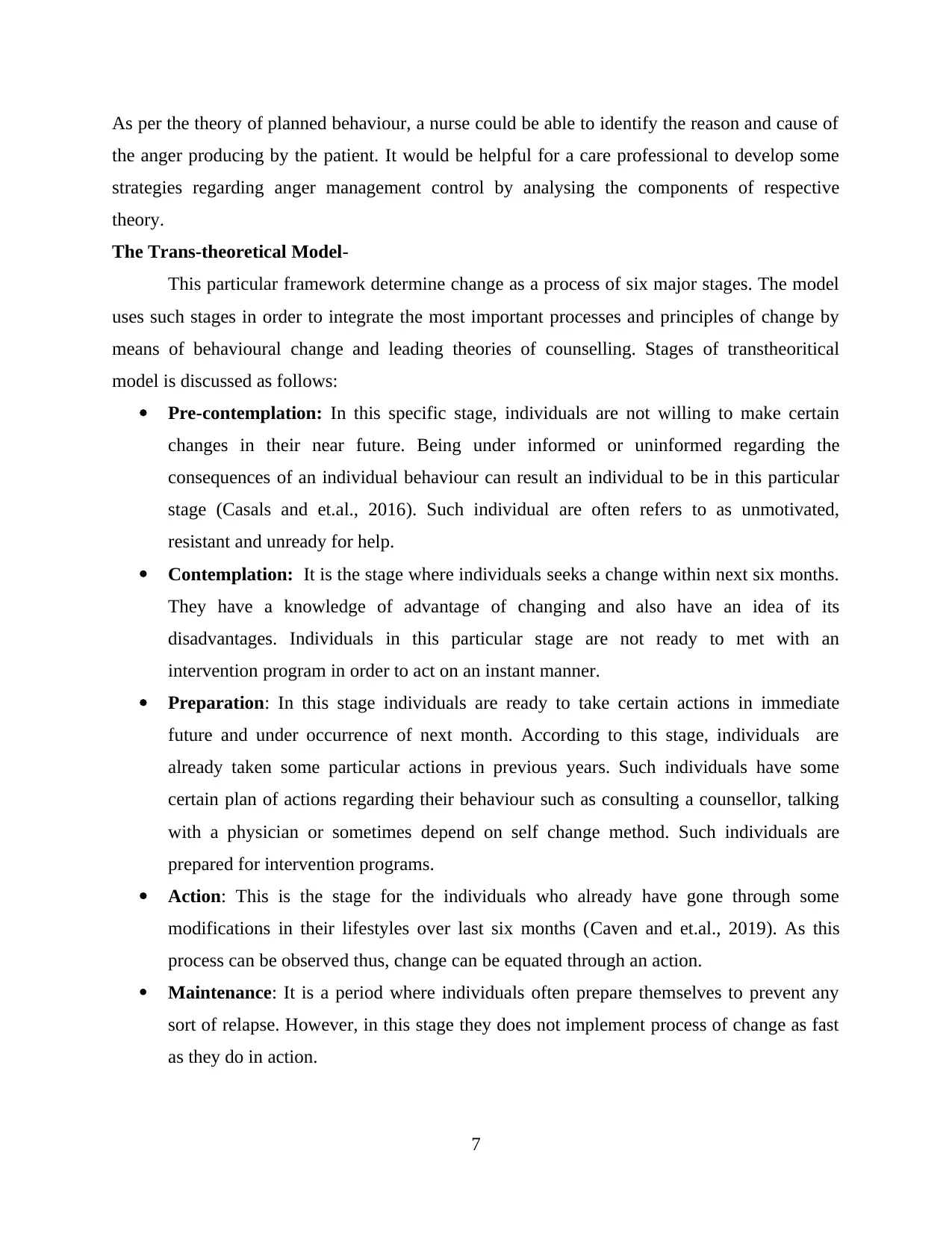
As per the theory of planned behaviour, a nurse could be able to identify the reason and cause of
the anger producing by the patient. It would be helpful for a care professional to develop some
strategies regarding anger management control by analysing the components of respective
theory.
The Trans-theoretical Model-
This particular framework determine change as a process of six major stages. The model
uses such stages in order to integrate the most important processes and principles of change by
means of behavioural change and leading theories of counselling. Stages of transtheoritical
model is discussed as follows:
Pre-contemplation: In this specific stage, individuals are not willing to make certain
changes in their near future. Being under informed or uninformed regarding the
consequences of an individual behaviour can result an individual to be in this particular
stage (Casals and et.al., 2016). Such individual are often refers to as unmotivated,
resistant and unready for help.
Contemplation: It is the stage where individuals seeks a change within next six months.
They have a knowledge of advantage of changing and also have an idea of its
disadvantages. Individuals in this particular stage are not ready to met with an
intervention program in order to act on an instant manner.
Preparation: In this stage individuals are ready to take certain actions in immediate
future and under occurrence of next month. According to this stage, individuals are
already taken some particular actions in previous years. Such individuals have some
certain plan of actions regarding their behaviour such as consulting a counsellor, talking
with a physician or sometimes depend on self change method. Such individuals are
prepared for intervention programs.
Action: This is the stage for the individuals who already have gone through some
modifications in their lifestyles over last six months (Caven and et.al., 2019). As this
process can be observed thus, change can be equated through an action.
Maintenance: It is a period where individuals often prepare themselves to prevent any
sort of relapse. However, in this stage they does not implement process of change as fast
as they do in action.
7
the anger producing by the patient. It would be helpful for a care professional to develop some
strategies regarding anger management control by analysing the components of respective
theory.
The Trans-theoretical Model-
This particular framework determine change as a process of six major stages. The model
uses such stages in order to integrate the most important processes and principles of change by
means of behavioural change and leading theories of counselling. Stages of transtheoritical
model is discussed as follows:
Pre-contemplation: In this specific stage, individuals are not willing to make certain
changes in their near future. Being under informed or uninformed regarding the
consequences of an individual behaviour can result an individual to be in this particular
stage (Casals and et.al., 2016). Such individual are often refers to as unmotivated,
resistant and unready for help.
Contemplation: It is the stage where individuals seeks a change within next six months.
They have a knowledge of advantage of changing and also have an idea of its
disadvantages. Individuals in this particular stage are not ready to met with an
intervention program in order to act on an instant manner.
Preparation: In this stage individuals are ready to take certain actions in immediate
future and under occurrence of next month. According to this stage, individuals are
already taken some particular actions in previous years. Such individuals have some
certain plan of actions regarding their behaviour such as consulting a counsellor, talking
with a physician or sometimes depend on self change method. Such individuals are
prepared for intervention programs.
Action: This is the stage for the individuals who already have gone through some
modifications in their lifestyles over last six months (Caven and et.al., 2019). As this
process can be observed thus, change can be equated through an action.
Maintenance: It is a period where individuals often prepare themselves to prevent any
sort of relapse. However, in this stage they does not implement process of change as fast
as they do in action.
7
Paraphrase This Document
Need a fresh take? Get an instant paraphrase of this document with our AI Paraphraser
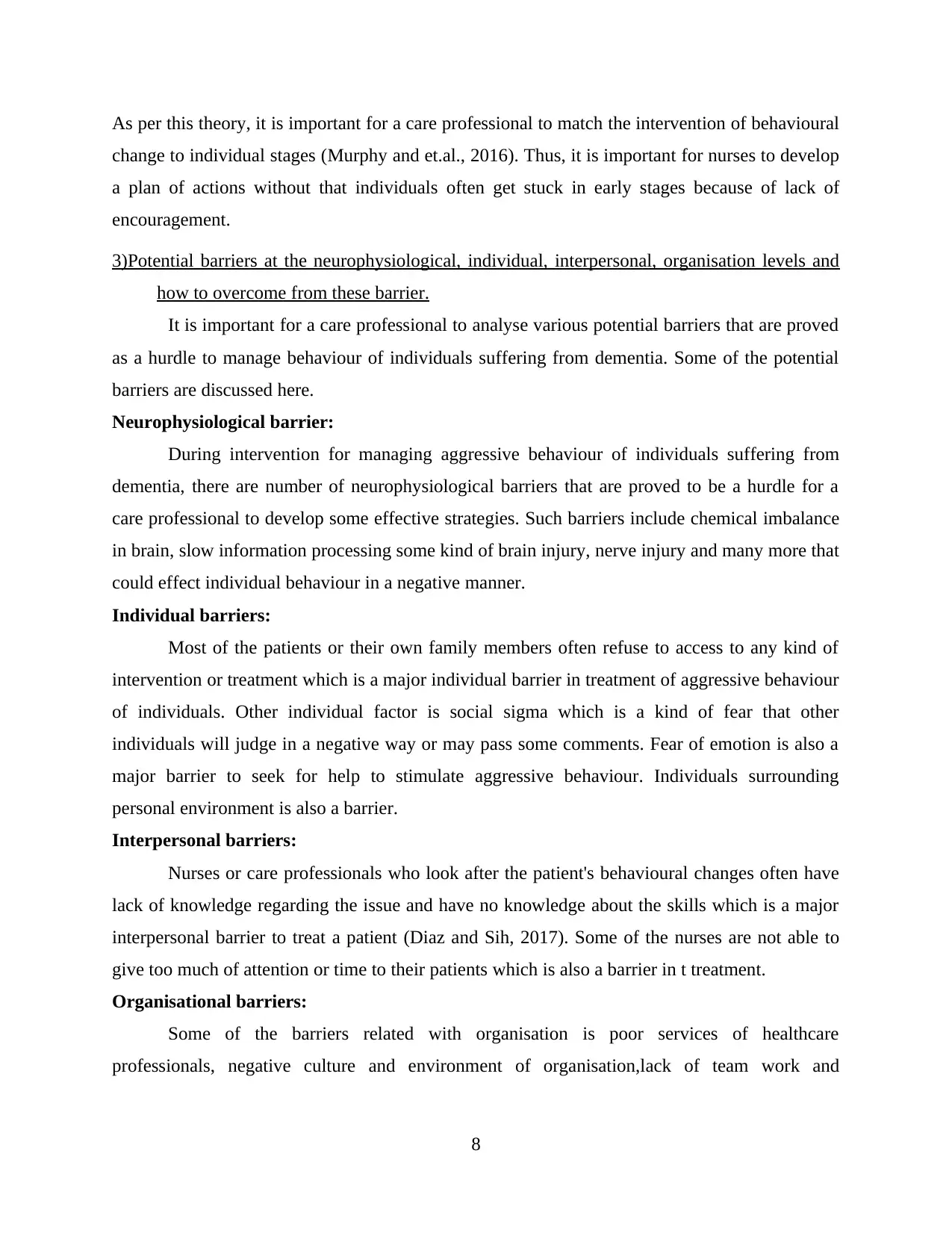
As per this theory, it is important for a care professional to match the intervention of behavioural
change to individual stages (Murphy and et.al., 2016). Thus, it is important for nurses to develop
a plan of actions without that individuals often get stuck in early stages because of lack of
encouragement.
3)Potential barriers at the neurophysiological, individual, interpersonal, organisation levels and
how to overcome from these barrier.
It is important for a care professional to analyse various potential barriers that are proved
as a hurdle to manage behaviour of individuals suffering from dementia. Some of the potential
barriers are discussed here.
Neurophysiological barrier:
During intervention for managing aggressive behaviour of individuals suffering from
dementia, there are number of neurophysiological barriers that are proved to be a hurdle for a
care professional to develop some effective strategies. Such barriers include chemical imbalance
in brain, slow information processing some kind of brain injury, nerve injury and many more that
could effect individual behaviour in a negative manner.
Individual barriers:
Most of the patients or their own family members often refuse to access to any kind of
intervention or treatment which is a major individual barrier in treatment of aggressive behaviour
of individuals. Other individual factor is social sigma which is a kind of fear that other
individuals will judge in a negative way or may pass some comments. Fear of emotion is also a
major barrier to seek for help to stimulate aggressive behaviour. Individuals surrounding
personal environment is also a barrier.
Interpersonal barriers:
Nurses or care professionals who look after the patient's behavioural changes often have
lack of knowledge regarding the issue and have no knowledge about the skills which is a major
interpersonal barrier to treat a patient (Diaz and Sih, 2017). Some of the nurses are not able to
give too much of attention or time to their patients which is also a barrier in t treatment.
Organisational barriers:
Some of the barriers related with organisation is poor services of healthcare
professionals, negative culture and environment of organisation,lack of team work and
8
change to individual stages (Murphy and et.al., 2016). Thus, it is important for nurses to develop
a plan of actions without that individuals often get stuck in early stages because of lack of
encouragement.
3)Potential barriers at the neurophysiological, individual, interpersonal, organisation levels and
how to overcome from these barrier.
It is important for a care professional to analyse various potential barriers that are proved
as a hurdle to manage behaviour of individuals suffering from dementia. Some of the potential
barriers are discussed here.
Neurophysiological barrier:
During intervention for managing aggressive behaviour of individuals suffering from
dementia, there are number of neurophysiological barriers that are proved to be a hurdle for a
care professional to develop some effective strategies. Such barriers include chemical imbalance
in brain, slow information processing some kind of brain injury, nerve injury and many more that
could effect individual behaviour in a negative manner.
Individual barriers:
Most of the patients or their own family members often refuse to access to any kind of
intervention or treatment which is a major individual barrier in treatment of aggressive behaviour
of individuals. Other individual factor is social sigma which is a kind of fear that other
individuals will judge in a negative way or may pass some comments. Fear of emotion is also a
major barrier to seek for help to stimulate aggressive behaviour. Individuals surrounding
personal environment is also a barrier.
Interpersonal barriers:
Nurses or care professionals who look after the patient's behavioural changes often have
lack of knowledge regarding the issue and have no knowledge about the skills which is a major
interpersonal barrier to treat a patient (Diaz and Sih, 2017). Some of the nurses are not able to
give too much of attention or time to their patients which is also a barrier in t treatment.
Organisational barriers:
Some of the barriers related with organisation is poor services of healthcare
professionals, negative culture and environment of organisation,lack of team work and
8
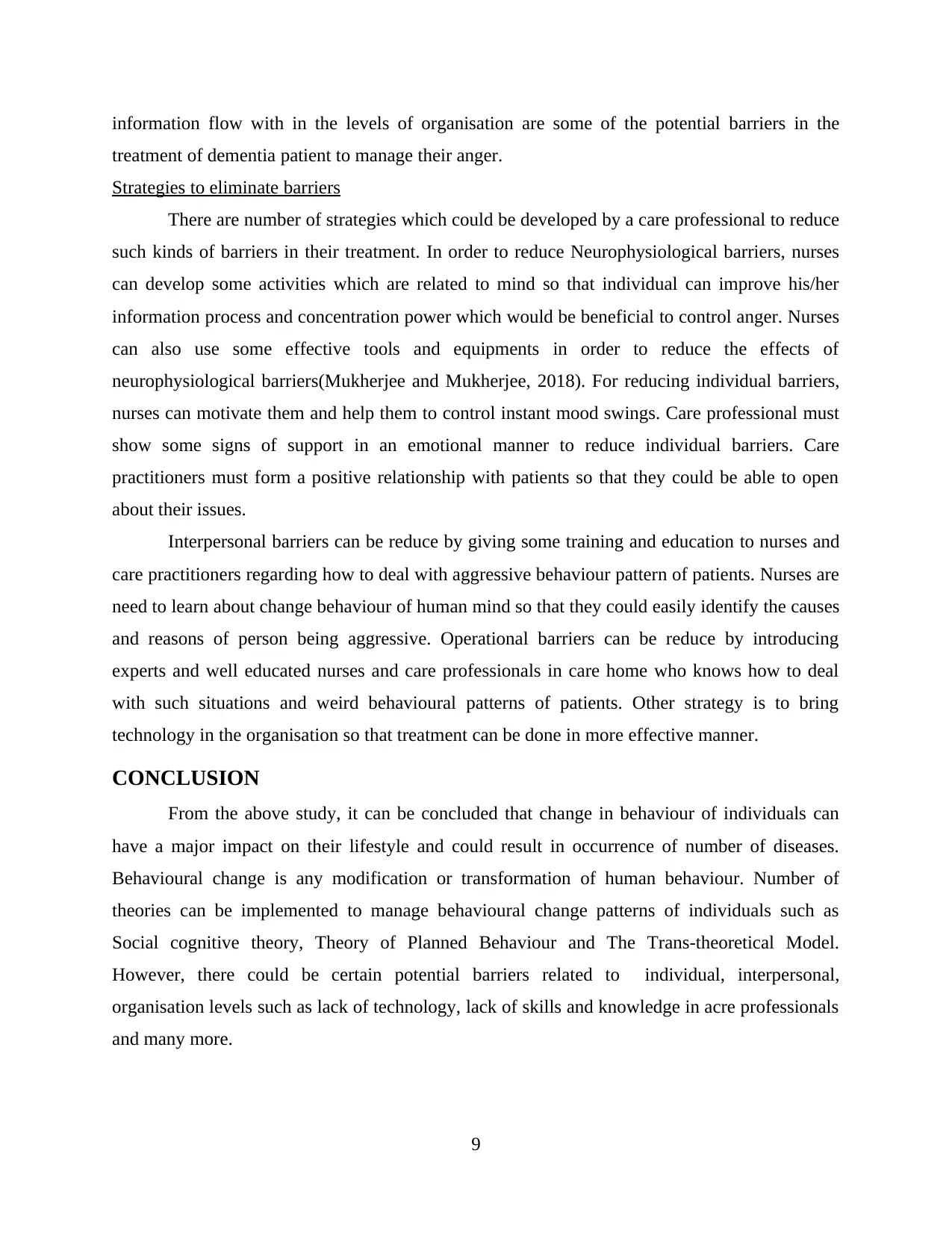
information flow with in the levels of organisation are some of the potential barriers in the
treatment of dementia patient to manage their anger.
Strategies to eliminate barriers
There are number of strategies which could be developed by a care professional to reduce
such kinds of barriers in their treatment. In order to reduce Neurophysiological barriers, nurses
can develop some activities which are related to mind so that individual can improve his/her
information process and concentration power which would be beneficial to control anger. Nurses
can also use some effective tools and equipments in order to reduce the effects of
neurophysiological barriers(Mukherjee and Mukherjee, 2018). For reducing individual barriers,
nurses can motivate them and help them to control instant mood swings. Care professional must
show some signs of support in an emotional manner to reduce individual barriers. Care
practitioners must form a positive relationship with patients so that they could be able to open
about their issues.
Interpersonal barriers can be reduce by giving some training and education to nurses and
care practitioners regarding how to deal with aggressive behaviour pattern of patients. Nurses are
need to learn about change behaviour of human mind so that they could easily identify the causes
and reasons of person being aggressive. Operational barriers can be reduce by introducing
experts and well educated nurses and care professionals in care home who knows how to deal
with such situations and weird behavioural patterns of patients. Other strategy is to bring
technology in the organisation so that treatment can be done in more effective manner.
CONCLUSION
From the above study, it can be concluded that change in behaviour of individuals can
have a major impact on their lifestyle and could result in occurrence of number of diseases.
Behavioural change is any modification or transformation of human behaviour. Number of
theories can be implemented to manage behavioural change patterns of individuals such as
Social cognitive theory, Theory of Planned Behaviour and The Trans-theoretical Model.
However, there could be certain potential barriers related to individual, interpersonal,
organisation levels such as lack of technology, lack of skills and knowledge in acre professionals
and many more.
9
treatment of dementia patient to manage their anger.
Strategies to eliminate barriers
There are number of strategies which could be developed by a care professional to reduce
such kinds of barriers in their treatment. In order to reduce Neurophysiological barriers, nurses
can develop some activities which are related to mind so that individual can improve his/her
information process and concentration power which would be beneficial to control anger. Nurses
can also use some effective tools and equipments in order to reduce the effects of
neurophysiological barriers(Mukherjee and Mukherjee, 2018). For reducing individual barriers,
nurses can motivate them and help them to control instant mood swings. Care professional must
show some signs of support in an emotional manner to reduce individual barriers. Care
practitioners must form a positive relationship with patients so that they could be able to open
about their issues.
Interpersonal barriers can be reduce by giving some training and education to nurses and
care practitioners regarding how to deal with aggressive behaviour pattern of patients. Nurses are
need to learn about change behaviour of human mind so that they could easily identify the causes
and reasons of person being aggressive. Operational barriers can be reduce by introducing
experts and well educated nurses and care professionals in care home who knows how to deal
with such situations and weird behavioural patterns of patients. Other strategy is to bring
technology in the organisation so that treatment can be done in more effective manner.
CONCLUSION
From the above study, it can be concluded that change in behaviour of individuals can
have a major impact on their lifestyle and could result in occurrence of number of diseases.
Behavioural change is any modification or transformation of human behaviour. Number of
theories can be implemented to manage behavioural change patterns of individuals such as
Social cognitive theory, Theory of Planned Behaviour and The Trans-theoretical Model.
However, there could be certain potential barriers related to individual, interpersonal,
organisation levels such as lack of technology, lack of skills and knowledge in acre professionals
and many more.
9

REFERENCES
Books and Journals
Pothitou, M., and et.al., 2016. A framework for targeting household energy savings through
habitual behavioural change. International Journal of Sustainable Energy. 35(7)
pp.686-700.
Verelst, F., and et.al., 2016. Behavioural change models for infectious disease transmission: a
systematic review (2010–2015). Journal of The Royal Society Interface. 13(125).
p.20160820.
Larsen, M.L.V.,and et.al., 2016. Can tail damage outbreaks in the pig be predicted by
behavioural change?. The Veterinary Journal. 209. pp.50-56.
Warren, C., Becken, S. and Coghlan, A., 2017. Using persuasive communication to co-create
behavioural change–engaging with guests to save resources at tourist accommodation
facilities. Journal of Sustainable Tourism. 25(7). pp.935-954.
Gronau, W., 2017. Encouraging behavioural change towards sustainable tourism: a German
approach to free public transport for tourists.Journal of sustainable Tourism. 25(2).
pp.265-275.
Olins, W., 2017. The new guide to identity: How to create and sustain change through managing
identity. Routledge.
Nauta, M., 2016. Detecting Hacked Twitter Accounts by Examining Behavioural Change using
Twtter Metadata. In Proceedings of the 25th Twente Student Conference on IT.
Hafner, R.J., Elmes, D. and Read, D., 2019. Promoting behavioural change to reduce thermal
energy demand in households: A review. Renewable and Sustainable Energy Reviews.
102. pp.205-214.
Casals, M., and et.al., 2016. Promoting energy users' behavioural change in social housing
through a serious game.
Caven, M., and et.al., 2019. Impact of hepatitis C treatment on behavioural change in relation to
drug use in people who inject drugs: a systematic review. International Journal of Drug
Policy. 72. pp.169-176.
Murphy, K.M., and et.al., 2016. The case for behavioural change counselling for the prevention
of NCDs and improvement of self-management of chronic conditions. South African
Family Practice. 58(6). pp.249-252.
Diaz Pauli, B. and Sih, A., 2017. Behavioural responses to human‐induced change: Why fishing
should not be ignored. Evolutionary Applications. 10(3). pp.231-240.
Mukherjee, I. and Mukherjee, N., 2018. Designing for sustainable outcomes: espousing
behavioural change into co-production programmes. Policy and Society. 37(3). pp.326-
346.
10
Books and Journals
Pothitou, M., and et.al., 2016. A framework for targeting household energy savings through
habitual behavioural change. International Journal of Sustainable Energy. 35(7)
pp.686-700.
Verelst, F., and et.al., 2016. Behavioural change models for infectious disease transmission: a
systematic review (2010–2015). Journal of The Royal Society Interface. 13(125).
p.20160820.
Larsen, M.L.V.,and et.al., 2016. Can tail damage outbreaks in the pig be predicted by
behavioural change?. The Veterinary Journal. 209. pp.50-56.
Warren, C., Becken, S. and Coghlan, A., 2017. Using persuasive communication to co-create
behavioural change–engaging with guests to save resources at tourist accommodation
facilities. Journal of Sustainable Tourism. 25(7). pp.935-954.
Gronau, W., 2017. Encouraging behavioural change towards sustainable tourism: a German
approach to free public transport for tourists.Journal of sustainable Tourism. 25(2).
pp.265-275.
Olins, W., 2017. The new guide to identity: How to create and sustain change through managing
identity. Routledge.
Nauta, M., 2016. Detecting Hacked Twitter Accounts by Examining Behavioural Change using
Twtter Metadata. In Proceedings of the 25th Twente Student Conference on IT.
Hafner, R.J., Elmes, D. and Read, D., 2019. Promoting behavioural change to reduce thermal
energy demand in households: A review. Renewable and Sustainable Energy Reviews.
102. pp.205-214.
Casals, M., and et.al., 2016. Promoting energy users' behavioural change in social housing
through a serious game.
Caven, M., and et.al., 2019. Impact of hepatitis C treatment on behavioural change in relation to
drug use in people who inject drugs: a systematic review. International Journal of Drug
Policy. 72. pp.169-176.
Murphy, K.M., and et.al., 2016. The case for behavioural change counselling for the prevention
of NCDs and improvement of self-management of chronic conditions. South African
Family Practice. 58(6). pp.249-252.
Diaz Pauli, B. and Sih, A., 2017. Behavioural responses to human‐induced change: Why fishing
should not be ignored. Evolutionary Applications. 10(3). pp.231-240.
Mukherjee, I. and Mukherjee, N., 2018. Designing for sustainable outcomes: espousing
behavioural change into co-production programmes. Policy and Society. 37(3). pp.326-
346.
10
Secure Best Marks with AI Grader
Need help grading? Try our AI Grader for instant feedback on your assignments.

11

12

13
1 out of 13
Related Documents
Your All-in-One AI-Powered Toolkit for Academic Success.
+13062052269
info@desklib.com
Available 24*7 on WhatsApp / Email
![[object Object]](/_next/static/media/star-bottom.7253800d.svg)
Unlock your academic potential
© 2024 | Zucol Services PVT LTD | All rights reserved.





